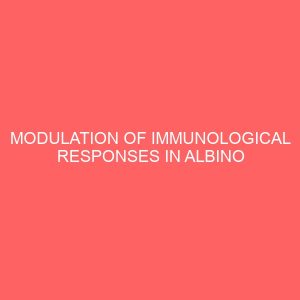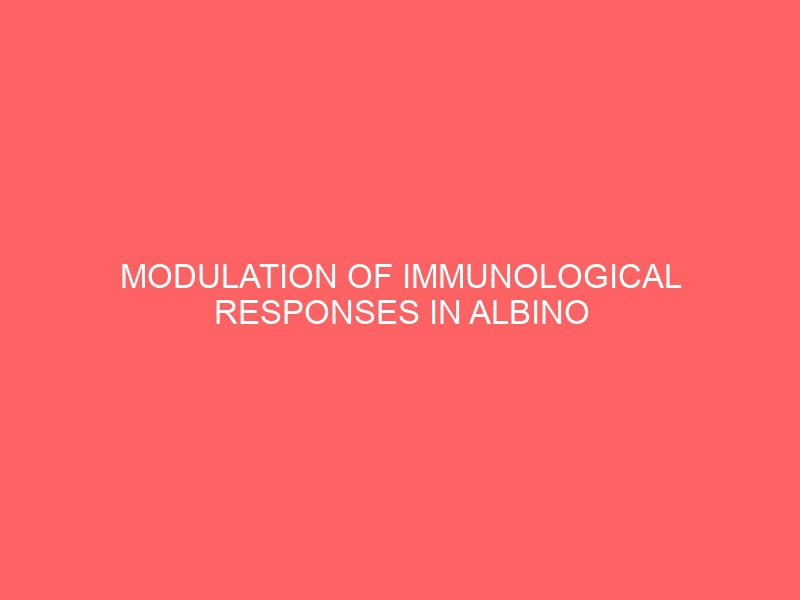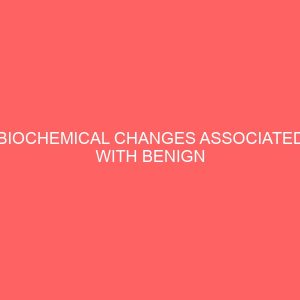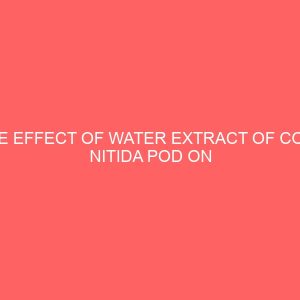Description
CHAPTER ONE
INTRODUCTION
This research is on Modulation of immunological responses in albino rats by leaf extracts of telfairia occidentalis (hook f) and tectona grandis (linn). The reality of our modern society shows a preponderance of activities that elevate free radicals generation, engender stress, ultimately weaken the immune system and increase susceptibility to infections and diseases. The immune system is a system of biological structure and processes within an organism that protect against disease. It is designed to protect the host from invading pathogens and to eliminate disease (Sharmaet al., 2004; Naga and Rajeshwari, 2014).Immune system is core to maintenance of health and general well-being and is intricately associated with the four major causes of death which include injury, infection, degenerative disorders and cancer. Immunity is concerned with the recognition and disposal of foreign materials that enter the body while immunology is the study of how immune components respond and interact, of the consequences (desirable and otherwise), of their activity and of the ways in which they can be advantageously increased or reduced. There are two aspects of immune protection, the innate response and the adaptive response (Atal et al., 1986; Guyton and Hall, 2006). Innate immunity is present at birth, and provides the first barrier against infectious micro-organisms. Adaptive immunity is the second barrier against infections. It is acquired later in life and retains a memory of the invaders it has encountered (Nworu, 2007). Innate and adaptive mechanisms can be modified by substances to either enhance or suppress the ability to resist invasion by pathogens (Williams and Barclay 1988).
The immune system is known to be involved in the etiology as well as the pathophysiologic mechanism of many diseases (Kalpeshet al., 2009). Immunology is thus probably one of the most rapidly developing areas of biomedical research holding great promise with regard to prevention and treatment of a wide range of disorders (Patilet al., 2012). Key elements of the immune response include recognition of self and non-self (Karlsen and Dryberg, 1998), regulation of immune response (Jerne, 1984); termination of immune response after effective control of offending agent (Parjis and Abbas, 1998) and establishment of a repertoire of memory cells for the future. The rise in immunological disorders confronting mankind today is alarming. This rise is due to different etiologies including environmental and nutritional habits. Disorders of the immune system include multiple sclerosis, arthritis, congestive heart failure, autoimmune disorders, several inflammatory disorders and infectious diseases such as AIDS, malaria, typhoid fever and the most dreaded Ebola virus disease. Immune function disorder is responsible for these and other diseases (Patwardhan et al., 1990). The immune system can be influenced by nutritional/metabolic status (Procaccini et al., 2013). Agents that alter the immune system either by stimulating or suppressing it are of great significance in managing immunological disorders and are known as immune-modulators (Srivathsa, 2006). Modulation of immune responses to alleviate various diseases has been of interest for many years (Sharma et al., 2004). In HIV and other infectious diseases, stimulation/up-regulation of the immune system is a highly desired goal. Immuno-stimulatory therapy is now recognized as an alternative to conventional chemotherapy for a variety of disease conditions involving impaired immune response of the host (Upadhaya, 2007; Ganjuet al., 2003). Immuno-stimulators are known to support T-cell function, activate macrophages and granulocytes and complement natural killer cells apart from the production of various effector molecules generated by activated cells (Wagner et al., 2003). The function and the efficacy of the immune system may be influenced by many exogenous factors like food and pharmaceuticals, physical and psychological stress and hormones. An immune-modulator essentially helps to optimize immune function by normalizing the process and thereby maintaining balance. Immune regulation is a complex balance between regulatory and effector cells and any imbalance in immunological mechanism can lead to a disease condition (Sehraet al., 2008). In healthy individuals immune-stimulants are expected to serve as prophylactic or promotive agents by enhancing basal levels of immune response and in individuals with impaired immunity they act as immunotherapeutic agent (Agrawal and Singh, 1999).
The immune system of humans is intricately interwoven with oxidative processes in the body. High oxidative stress usually breaks down the immune system, precipitates radicals as well as severe diseases and this must be prevented (Halliwell, 1992). Studies have emphasized the therapeutic importance of plant-derived immune-modulants with antioxidant activities (Allam, 2009; Guo et al., 2009). Modulation of the immune system as well as optimizing oxidative processes of the body with aid of natural products represents a field of drug development-based research witnessing unprecedented upsurge in recent times (Nworu, 2007). A newer approach to therapeutics is to search for potent immune-modulating substances preferably with synergistic antioxidant activity. Indeed there has been growing interest in isolating and characterizing compounds with immune-modulatory and antioxidant activities (Wang et al., 2004). It has been established that most pharmacologic activities are related to the immune-modulatory and antioxidant activities of plant secondary metabolites (Okonji et al., 1999).
More than a quarter of medicines in use today come from plants and these medicinal plants serve as therapeutic alternatives, safer choices or in some cases as the only effective treatment (Sharififaret al., 2009). The unmatched availability and chemical diversity characterizing natural products provide unlimited opportunities for development of new drug leads (Cos et al., 2006). Natural products are still major sources of innovative therapeutic agents for various conditions including infectious diseases (Clardy and Walsh 2004). Increased interest in herbs has prompted scientific scrutiny of their therapeutic potential and safety (Atal et al., 1986). The use of products of plants and animal origin as medicinal agents is predicated upon the belief that they promote positive health and maintain organic resistance against infections by re-establishing the bodys̓equilibrium and conditioning of body tissues(Fulzele et al., 2003). Use of plant remedies again is perceived as a natural approach to disease treatment. Equally medicinal plants are rich sources of substances which are claimed to induce para-immunity (Koreet al., 2010) and relieve oxidative stress (Njoku and Adikwu, 1997). Phytochemical constituents such as terpenoids, steroids, proteins, tannins and flavonoids are considered responsible for immune-modulatory properties exhibited by plants (Kuo et al., 2004).Telfairia occidentalis Hook F and Tectona grandis Linn are well known for haematinic and other medicinal properties. However there is no documented evidence of any seriousinvestigation of their immune-modulatory effects (Kayode and Kayode, 2010). The search for safe and potent immune-modulating substances preferably with synergistic antioxidant activities continues to attract great research interest (Wang et al., 2004). Thereis no doubt that immune-modulators hold great promise for control and prevention of infections but is yet to be fully exploited (Nworu, 2007).
1.1.1 Immuno-modulation
Immuno-modulation is a process which alters the immune system of an organism by interfering with its functions (Agrawal, 2010). An immuno-modulator therefore is a substance, biological or synthetic which can stimulate, suppress or modulate any of the components of the immune system. This could result in immuno-stimulation/enhancement or immuno-suppression (Dhasarathan et al., 2010; Vinothapooshan and Sundar, 2011). Immuno-modulatorsalter the immune system by interacting with it to up-regulate or down-regulate specific aspect of the host response (Stanilove et al., 2005; Utoh-Nedosa et al., 2009) they are of great importance in treating immunological disorders (Srivathsa, 2006). They are also known as biologic response modifiers or immunoregulators which function as drugs, leading predominantly to a non-specific stimulation of immunological defense mechanisms (Tzianabos, 2010). Regulation of the immune response by an immunoregulator is a normalization process that helps to optimize the immune response (Sehra et al., 2008; Agrawal, 2010). Immunomodulators may include some bacterial products, lymphokines and plant derived substances. The effects of immunomodulators can be classified into three which are stimulation, suppression and restoration of the immune system. Unlike vaccines, most immunomodulatory agents are not real antigens but antigenomimetics or so-called mitogens. They do not stimulate the development of memory lymphocytes, thus the effect of immunomodulatory agents towards specific immune system will be reduced after a short of period of time (Wagner and Fintelman, 1999). The ability of immunomodulators to enhance or suppress immune responses can depend on a number of factors such as dosage, route of administration, timing and frequency of administration (Tzianabos, 2010). Immunomodulation generally entails the adjustment of the immune system to the desired level and could be achieved by the use of natural as well as synthetic agents from plants and chemicals respectively. The immunomodulatory effect of plants can be explained most preferably using two scenario:immuno-stimulation and immuno-suppression.
1.1.1.2 Immuno-stimulation
Immuno-stimulation is a process that involves the activation of the immune system activity and that of its components. Immuno-stimulatory agents are used often to achieve this purpose and are grouped into specific and non-specific immune stimulants. Biologic response modifiers (BRM) are substances that stimulate the body’s response to infection and disease. The body is known to produce these substances in inappreciable quantity hence the need for exogenous supplementation from diets and pharmaceuticals. Immunostimulators are known to support T-cell function, activate macrophages, granulocytes and complement natural killer cells apart from affecting the production of various effector molecules generated by activated cells (Wagner et al., 2003). Immunostimulatory therapy has been long recognized as alternative to conventional chemotherapy for a variety of disease conditions involving the impaired immune response of the host (Ganju et al., 2003).
1.1.1.3 Immuno-suppression
Immunosuppression is a component of immune modulation and involves the reduction of the activation or efficacy of the immune system. It also involves altering the sensitivity of the immune system and this can be achieved by the use of immuno-suppressive agents. Some portions of the immune system itself have immuno-suppressive effects on other parts and immunosuppression may occur as an adverse reaction to treatment of other conditions. Cytokines have been found to preferentially suppress or stimulate the production of immune cells depending on the prevailing conditions (Liu et al., 2013).The immune system can be manipulated to suppress unwanted responses resulting from autoimmunity and allergy. It therefore functions by reducing the effectiveness of the immune systems response to foreign substances. Other substances that induce immune suppression include rapamycin, pyrogallol and cyclophosphamide (Diken et al., 2013).
In general, immuno-suppression can be induced in some special cases such asin organ transplantto prevent graft rejection and in treating auto-immune diseases.
1.2 Innate Immune System
The innate immunity is present at birth and does not require specific recognition of an antigen by the immune system (Vollmar, 2005). It is the first line of defense and is primarily mediated by various kinds of natural barriers including physical, chemical and enzymatic barriers. Innate immunity is involved in both humoral and cellular arms of immune response, to protect the host against a vast and diversified range of microbes and their products. The humoral effectors of innate immunity consist of families of soluble proteins such as complement and acute-phase response proteins. These are not only important for the initial neutralization or elimination of microbes, but also alert the host’s immunity through the recruitment of a variety of cells at the site of infection of tissue injury. The cellular arm consists of “nonprofessional” somatic cells such as epithelial cells and “professional” immune cells such as various types of tissue phagocytic cells and dendritic cells (Himanshu and Adrian, 2013).The cells of the innate immune system such as dendritic cells (DCs), detect and respond to pathogens through the expression of pattern recognition receptors (PRRs) including Toll-like receptors (TLRs), Nod-like receptors, and Dectin-1(Manicassamy and Pulendra, 2009; Takeuchi and Akira, 2010). PRRs bind to β-1,3-glucans, such as curdlan, on the cell wall of the fungi and some bacteria (Brown et al., 2002), thereby activating DCs (Kennedy et al., 2007). This activation results in the production of cytokines which eventually modulate the type of T-cell response.
Through interaction with DCs, CD4+T-cells can differentiate into a variety of effectorand regulatory subsets, including classical T-helper1 and 2 cells, regulatory T-cells (Treg)and T-helper17 cells. It has been shown that the nature of the cytokines produced by DCs inresponse to various ligands determine the type of T-helper cell response.
1.2.1 Humoral Barriers to Infection
The anatomical barriers are very effective in preventing colonization of tissues by micro-organisms. However, when there is damage to tissues, the anatomical barriers are breached and infections may occur. Once infectious agents have penetrated tissues, another innate defence mechanism comes into play, namely: acute inflammation. Humoral factors play important roles in inflammation, which is characterized by oedema and the recruitment of phagocytic cells. These humoral factors are found in serum or they are formed at the site of infection.
1.2.1.1 Inflammatory Response
The inflammatory process is the reaction of blood vessels which brings about an accumulation of fluid and white blood cells in the extra vascular tissues (Cotran, 1998).Infection with a pathogen triggers an acute inflammatoryresponse in which cellsand molecules ofthe immune system move into the affected site. Theactivation ofcomplement generates C3b, which coatsthe surface of the pathogen. Substancesreleased from the pathogen and from damaged tissuesup-regulate the expression of adhesion moleculeson vascular endothelium,alerting passing cells tothe presence of infection. The cell-surface moleculeL-selectin on neutrophils recognizes carbohydratestructures such as sialyl-LewisXon the vascular adhesionmolecules.The neutrophil rolling along thevesselwall is arrested in its course by these interactions.As the neutrophil becomes activated, it rapidlysheds L-selectin from its surface and replaces it withother cell-surface adhesion molecules, such as the integrins.These integrins bind the molecule E-selectin,which appears on the blood-vessel wall under the influenceof inflammatory mediators such as bacteriallipopolysaccharide and the cytokines;interleukin-1and tumor necrosis factor-α. Complement components,prostaglandins, leukotrienes and other inflammatorymediators all contribute to the recruitmentof inflammatory cells as does an important group ofchemoattractant cytokines; the chemokines (Ogawa and Calhoun, 2006).
Inflammation is an important non-specific defense reaction of tissue injury, such as that caused by a pathogen or wound (Prescott et al., 2005). It is one of the first responses of the immune system to infection (Kawai and Akira, 2006). The symptoms are redness, swelling, heat and pain, which are caused by increased blood flow into tissue. Inflammation is produced by eicosanoids and cytokines, which are released by injured or infected cells. Eicosanoids include prostaglandins that produce fever and the dilation of blood vessels associated with inflammation and leukotrienes that attract certain white blood cells (Miller, 2006). Common cytokines include interleukins that are responsible for communication between white blood cells; chemokines that promote chemotaxis and interferons that have anti-viral effects, such as shutting down protein synthesis in the host cell (Leet al., 2004). Growth factors and cytotoxic factors may also be released. These cytokines and other chemicals recruit immune cells to the site of infection and promote healing of any damaged tissue following the removal of pathogens (Martins and Leibovich, 2005).Inflammation is part of the complex biological response of vascular tissues to harmful stimuli, such as pathogens, damaged cells, or irritants. When tissues receive injurious stimuli, they inflame to remove them and to initiate the healing process (Ferrero-Millianiet al., 2007). It is a stereotyped response and therefore considered a mechanism of innate immunity (Abbas et al., 2007).
Inflammation can be classified as either acute or chronic. Acute inflammation is the initial response of the body to harmful stimuli and is achieved by the increased movement of plasma and leukocytes (especially granulocytes) from the blood into the injured tissues. The intravascular cells important to inflammation are neutrophils, eosinophils, basophils, lymphocytes and monocytes. The process of acute inflammation is initiated by cells already present in all tissue mainly resident macrophages, dendritic cells, mastocytes, among others. These cells contain ‘pattern recognition receptors’ (PRRs) which recognize molecules that are broadly shared by pathogens but distinguishable from host molecule and collectively referred to as pathogen-associated molecular patterns (PAMPs). At the onset of aninfection, burn or other injuries; these cells undergo activation and release inflammatory mediators responsible for the clinical signs of inflammation (Cotran, 1998). Vasodilation and its resulting increased blood flow cause the redness and increased heat. Prolonged inflammation known as chronic inflammation leads to progressive shift in the type of cells present at the site of inflammation and is characterized by simultaneous destruction and healing of the tissue from the inflammatory process (Liszewski et al., 1996). Chronic inflammation can however lead to a host of diseases such as hay fever, periodontitis, atherosclerosis, rheumatoid arthritis and even cancer.Inflammatory mediators have short half-lives and are quickly degraded in the tissue. Hence acute inflammation ceases once the stimulus has been removed.Chronic inflammation on the other hand is a more severe type of inflammation as it is prolonged.
The chemical factors produced during inflammation include histamine, bradykinin, serotonin, prostaglandins and leukotrienes. These factors sensitize pain receptors, causing vasodilation of the blood vessels at the scene and then attract phagocytes especially neutrophils(Stvitnovaet al., 1995) which then trigger other parts of the immune system by releasing factors that summon other leukocytes and lymphocytes.
1.2.3 Components of the Innate Immune System
1.2.3.1 Complement System
The complement system is a biochemical cascade that attacks the surfaces of foreign cells. It comprises an assembly of over 20 liver-manufactured, soluble and cell-bound proteins and is named for its ability to “complement” the killing of pathogens by antibodies. Complement is the major humoral components of the innate immune response (Rus et al., 2005; Mayer, 2006). Many species have complement systems, including non-mammals like fish and some invertebrates. The complement cascade helps the ability of the antibodies and phagocytic cells to clear pathogens from an organism (Janeway, 2005). It can be recruited and brought into action by the adaptive immune system. Activationof the complement cascade by protease cleavage leads to chemotaxis (C5a), inflammation and increased capillary permeability (C3a, C5a), opsonization (C3b), and cytolysis. Sequential activationof the protein components of the complement cascadeupon cleavage by a protease, leads to each component’s becoming, in its turn, a protease (Rus et al., 2005). Three pathways are involved in complement attack upon pathogens: classical pathway, alternate pathway and mannose-binding lectin pathway (MBL-MAPS) (Abbas et al., 2010). The classical pathway utilizes C1, which is activated by binding of antibody to its cognate antigen. Activated C1 is a serine protease that cleaves C4 and C2 into small inactive fragments (C4a, C2a) and larger active fragments, C4band C2b. The active component C4b binds to the sugar moieties of surface glycoproteins and binds non-covalently to C2b, forming another serine protease(Arnold et al., 2006). Macrophages and neutrophils possess receptors for C3b, so cells coated with C3b are targetted for phagocytosis (opsonization). The small C3a fragment is released into solution where it can bind to basophils and mast cells, triggering histamine release and as an anaphylatoxin, potentially participating in anaphylaxis.C3 amplifies the humoral response because of its abundance and its ability to auto-activate.The alternative pathway is not activated by antigen-antibody binding but instead relies upon spontaneous conversion of C3 to C3b, which is rapidly inactivated by its binding toinhibitory proteins and sialic acidon the cell’s surface. The lectin pathway (MBL – MASP) is homologous to the classical pathway, but utilizes opsonin, mannan-binding lectin (MBL, MBP) and ficolinsrather than C1q(Liszewski et al., 1996).







